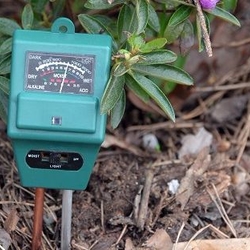(Editor's Note: This article was originally published on November 15, 2007. Your comments are welcome, but please be aware that authors of previously published articles may not be able to promptly respond to new questions or comments.)
A gardener growing plants without getting a soil test is like a surgeon performing an operation with a blindfold on.
Soil pH is a basic property that affects many chemical and biological activities in the soil. The degree of acidity or alkalinity is known as the soil pH. The scale runs from 0 which is highly acidic to 14.0 which is pure alkaline. A soil with a pH of 7.0 is termed to be neutral.
Each plant has its own requirements as far as pH and minerals in the soil. Most plants will do well if the pH range falls between 6.0 and 7.5.
However certain plants will not thrive if the pH falls outside of the desirable range of that particular plant. For example azaleas, hydrangeas, and rhododendrons prefer a pH in the 5.0-5.5 range. On the other hand clematis, delphiniums prefer soil with a pH in the 7.5-8.0 range.
Have you ever been disappointed with the performance of your vegetables or flowers, even though you gave them the best care you could? Truth is, pH might have been the problem. Plant roots absorb minerals such as nitrogen and iron only when they are dissolved in water. Now if this soil "soup" solution (the mixture of water and nutrients in the soil) is too acid or alkaline, some nutrients won't be dissolved, and as a result, they are unavailable to plants. They are said to be "locked up."
To put it another way, if the pH isn’t close to what these plants require, some nutrients, such as phosphorus, calcium and magnesium, can’t be dissolved in water. And since plants drink their food instead of eating it, if the nutrients aren’t dissolved first, the plant can’t absorb them. Thus, your corn, lettuce, roses and geraniums won't grow or produce to their full potential.
Most nutrients that plants need are readily available when the pH of the soil solution ranges from 6.0 to 7.5.
Below a pH of 6.0 (acid): Some nutrients such as nitrogen, phosphorus, and potassium are less available.
Above a pH of 7.5 (very alkaline): Iron, manganese, and phosphorus are less available.As an avid rose grower; I had heard several years ago that if you add a handful of Epsom salts (Magnesium sulfate) to each plant when you fertilize it will give the roses a boost. I should have known better but I’ve been adding Epsom salts to my roses for the past 3-4 years. I was quite shocked when I recently received the results of a soil test that I had done on my rose beds. The Magnesium levels were on the very high side of the scale.
I contacted the owner of one of the better rose nurseries in the area. She indicated that in this area (SE Michigan) the natural Magnesium levels are adequate for plants and no additional Magnesium is needed. She went on to say that the excess Magnesium itself should not hurt the plants, but it could prevent the roses from taking up other vital nutrients. This might explain why the performance of my roses was not up to par this past season.

You can purchase home soil test kits at most garden centers; however I recommend that for a few cents more you can get a much more through test from your county extension office. It will give you your pH as well as Phosphorus, Potassium, and Magnesium levels. More importantly if will give you fertilizer recommendation tailored to your specific garden and the crops that you are growing. For example in my case it recommends that I apply soil sulfur at a rate of 15 pounds per 1000 square feet to acidify my soil into the range that roses prefer.
For those of you wondering why soil tests don’t give you nitrogen readings. Nitrogen is transit in soil, that is it moves through the soil quickly and levels change at a rapid pace.

One last note, soil tests will also give you the amount of organic material in your soil. One thing that you can never get too much of is compost. Please, before adding any chemicals or fertilizers, get you soil tested to see what you have and what you need for the crop that you are growing.
By the way, fall is the perfect time to get your soil tested, the labs are far less busy than in the spring and early summer.
DON’T GUESS, SOIL TEST
















